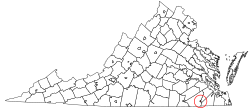Franklin, Virginia | |
|---|---|
 Downtown Franklin, Virginia | |
| Motto: "Growth – Community – Spirit" [1] | |
 Location in the Commonwealth of Virginia | |
| Coordinates: 36°40′38″N76°55′20″W / 36.67722°N 76.92222°W | |
| Country | |
| State | |
| County | None (Independent city) |
| Incorporated (Town) | March 1876 |
| Incorporated (City) | 1961 |
| Government | |
| • Mayor | Paul Kaplan |
| • Vice Mayor | Wynndolyn H. Copeland |
| Area | |
• Total | 8.37 sq mi (21.67 km2) |
| • Land | 8.28 sq mi (21.44 km2) |
| • Water | 0.089 sq mi (0.23 km2) |
| Elevation | 39 ft (12 m) |
| Population | |
• Total | 8,373 (2024 est.) |
| • Density | 1,011/sq mi (390.5/km2) |
| Time zone | UTC-5 (EST) |
| • Summer (DST) | UTC-4 (EDT) |
| ZIP code | 23851 |
| Area codes | 757, 948 |
| FIPS code | 51-29600 [3] |
| GNIS feature ID | 1494943 [4] |
| Website | www |
Franklin is the southwesternmost independent city in Hampton Roads, Commonwealth of Virginia. As of the 2020 census, the population was 8,180. [5] The Bureau of Economic Analysis combines the city of Franklin with Southampton County for statistical purposes.
Contents
- History
- Civil War
- Industrialization and the Camp family
- Geography
- Climate
- Demographics
- 2020 census
- 2010 census
- Economy
- Arts and culture
- Arts facilities and museums
- Events and festivals
- Architecture
- Sports
- Parks and recreation
- Government
- Education
- Infrastructure
- Transportation
- Healthcare
- Utilities
- Notable people
- See also
- References
- External links






